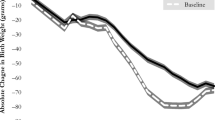Objectives: This study sought to examine state-specific trends in preterm delivery rates among non-Hispanic African Americans and to assess whether these rates are influenced by misclassification of gestational age. Methods: The sample population consisted of singleton non-Hispanic White and non-Hispanic African–American infants born in 1991 and 2001 to U.S. resident mothers. For both time periods, state-specific and national preterm delivery rates were calculated for all infants, stratified by infant race/ethnicity. Next, birth-weight distributions within strata of gestational age were studied to explore possible misclassifications of gestational age. Lastly, state-specific and national preterm delivery rates among infants who weighed less than 2,500 g were separately computed. Results: National analyses showed that the frequency of preterm delivery increased by 15.8% among non-Hispanic Whites but declined by 10.3% among non-Hispanic African Americans over the same period. For both subgroups, a bimodal distribution of birth weights was apparent among preterm births at 28–31 weeks of gestation. The second peak with its cluster of normal-weight infants was more prominent among non-Hispanic African Americans in 1991 than in 2001. After excluding preterm infants who weighed 2,500 g or more, the national trends persisted. State-specific analyses showed that preterm delivery rates increased for both subgroups in 13 states during this period. Of these 13, 6 states had a number of non-Hispanic African–American births classified as preterm that were apparently term births mistakenly assigned short gestational ages. Such misclassification was more frequent in 1991 than in 2001 and inflated 1991 rates. Conclusion: There is heterogeneity in state-specific preterm delivery rates. Such differences are often overlooked when aggregate results are presented.

Similar content being viewed by others
REFERENCES
State-specific changes in singleton preterm births among black and white women—United States, 1990 and 1997. MMWR Morb Mortal Wkly Rep 2000;49:837–40.
Preterm singleton births—United States, 1989–1996. MMWR Morb Mortal Wkly Rep 1999;185–9.
Demissie K, Rhoads GG, Ananth CV, Alexander GR, Kramer MS, Kogan MD, Joseph KS. Trends in preterm birth and neonatal mortality among blacks and whites in the United States from 1989 to 1997. Am J Epidemiol 2001;154:307–15.
Vahratian A, Buekens P, Bennett TA, Meyer RE, Kogan MD, Yu SM. Preterm delivery rates in North Carolina: Are they really declining among non-Hispanic African Americans? Am J Epidemiol 2004;159:59–63.
Alexander GR, Himes JH, Kaufman RB, Mor J, Kogan M. A United States national reference for fetal growth. Obstet Gynecol 1996;87:163–8.
Arbuckle T, Wilkins R, Sherman GJ. Birth weight percentiles by gestational age in Canada. Obstet Gynecol 1993;81:39–48.
David RJ. The quality and completeness of birthweight and gestational age data in computerized data files. Am J Public Health 1980;70:964–73.
Martin JA, Hamilton BE, Ventura SJ, Menacker F, Park MM, Sutton PD. Births: Final data for 2001. Natl Vital Stat Rep 2002;51:1–116.
Wilcox AJ. On the importance—and the unimportance—of birthweight. Int J Epidemiol 2001;30:1233–41.
Wilcox AJ, Russell IT. Birthweight and perinatal mortality. I. On the frequency distribution of birthweight. Int J Epidemiol 1983;12:314–8.
Kramer MS, McLean FH, Boyd ME, Usher RH. The validity of gestational age estimation by menstrual dating in term, preterm, and postterm gestations. JAMA 1988;260:3306–8.
Guerrero R, Florez PE. The duration of pregnancy [letter]. Lancet 1969;2:268–9.
Saito M, Yazawa K, Hashiguchi A, Kumasaka T, Nishi N, Kato K. Time of ovulation and prolonged pregnancy. Am J Obstet Gynecol 1972;112:31–8.
Gjessing HK, Skjaerven R, Wilcox AJ. Errors in gestational age: Evidence of bleeding early in pregnancy. Am J Public Health 1999;89:213–8.
ACKNOWLEDGMENTS
Dr. Vahratian was supported by the Building Interdisciplinary Research Careers in Women's Health (BIRCWH) program, National Institutes of Health (1 K12 HDO1438).
This research was presented in part at the 18th Annual Meeting of the Society for Pediatric and Perinatal Epidemiologic Research, Toronto, Canada, June 26–27, 2005.
Author information
Authors and Affiliations
Corresponding author
Rights and permissions
About this article
Cite this article
Vahratian, A., Buekens, P. & Alexander, G.R. State-Specific Trends in Preterm Delivery: Are Rates Really Declining Among Non-Hispanic African Americans Across the United States?. Matern Child Health J 10, 27–32 (2006). https://doi.org/10.1007/s10995-005-0032-4
Published:
Issue Date:
DOI: https://doi.org/10.1007/s10995-005-0032-4




